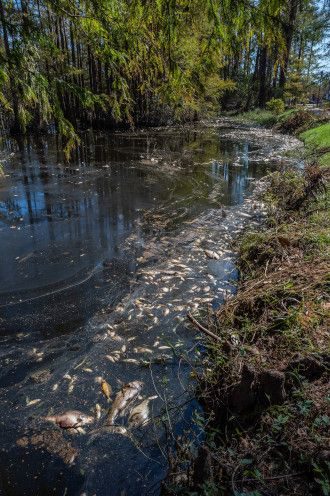By Abby Rabinowitz – While fossil fuels have become widely recognized as a major source of pollution, far less attention has been devoted to thermal pollution. Thermal pollution occurs when water used to cool power plants and factories is released into the environment at a higher temperature. Although this water is typically clean, it nevertheless causes significant environmental problems, such as harm to aquatic life, disrupted ecosystems and climate change.
What is Thermal Pollution?
Thermal pollution is pollution caused by adding heat to an ecosystem which adversely impacts the ecosystem. The U.S. Geologic Survey’s report Estimated Use of Water in the United States in 2005 estimates that power plants and industrial facilities withdraw approximately 219 billion gallons of cold water per day from surrounding ecosystems.
The primary purpose of this water is for cooling of industrial processes, which generate heat. In the U.S., about 75 to 82 percent of thermal pollution is generated by power plants. Other sources of thermal pollution may include: a nuclear power plant, coal power plant, industrial waste, petroleum refineries, sewage, pulp and paper mills, chemical plants, steel mills, smelters, hydro-electric power, and a thermal power plant. The water being returned by any of these systems can cause temperature changes and have detrimental effects on an aquatic ecosystem as well as aquatic animals.
Thermal Pollution in The USA
As of 2013, an estimated 1,260 facilities in the U.S. withdrew at least 2 million gallons per day of cooling water. Unlike a typical boiler system that reuses the same water over and over in a closed loop system, these facilities typically utilize “once-through” cooling systems that use cooling water once and immediately return it to the environment. Once-through cooling systems have been shown to return water at an average temperatures of 10 degrees Celsius warmer than above the ambient water temperature! As of 2014, there are over 1,200 facilities in the U.S alone which are using once-through cooling systems, however this is also a major global issue. By pumping this warm water into ecosystems, thermal pollution heats up surrounding water, greatly harming surrounding ecosystems.
The Effects of Thermal Pollution
Over millions of years, ecosystems have adapted to the Earth’s many changes. However, these changes occurred over long periods of time, far slower than what is happening right now as a result of thermal pollution. When the water temperature increases in a given area by even a few degrees Celsius, there can be significant implications for the present aquatic ecosystem.
The Effects of Thermal Shock
Sudden temperature changes can cause thermal shock, hurting plants, fish and other marine animals. This is because waste heat from the cooling process in power stations and power plants generates and discharges warm water, which in turn decreases oxygen levels, killing fish, changing the composition of food chains, and reducing the biodiversity of the ocean ecosystems. Furthermore, higher water temperatures reduce the capacity for oxygen to reach deeper waters, majorly decreasing the water quality for aquatic species. This creates anaerobic conditions which are more suitable to bacteria, shifting the balance of the food chain and overall ecosystem.
Why is Thermal Pollution Harmful to Ecosystems?
Why is warmer water so harmful to ecosystems? For starters, a warmer water temperature results in less oxygen in the water than in cooler water. The lack of oxygen kills fish and other aquatic species, while at the same time promoting anaerobic conditions that enable bacteria to thrive.
A prime example of this phenomenon exists in the Gulf of Mexico, where discharges from nearby rivers has created a hypoxic “dead zone” that has grown to 6,334 square miles or more than 4 million acres now uninhabitable by fish. An estimated 79 billion fish and other marine animals are killed every year in California waters alone as a result of thermal pollution! This shockingly high number attests to the detrimental impacts of thermal pollution in just one ecosystem.
Regulatory Framework for Thermal Pollution
Thermal pollution falls under the auspices of the Clean Water Act, which was enacted in 1948 and expanded in 1972. Section 316(a) governs sources of pollution with thermal discharges and empowers the U.S. Environmental Protection Agency (EPA) to regulate thermal discharges through National Pollutant Discharge Elimination System (NPDES) permitting authority.
The EPA has in turn delegated permitting authority to 46 states. The process requires power plants and factories to apply for discharge permits and obtain variances when proposed discharge amounts exceed statutory levels. Importantly, section 316(a) of the Clean Water Act prohibits plants without variance permits from raising river temperatures above threshold limits to the extent that electricity generation may need to be curtailed.
Regulatory Framework for Thermal Pollution In Practice
So if a regulatory process is already in place, why does such a problem exist? In theory, plants are obligated to submit detailed supporting information to prove that proposed thermal discharges will not adversely impact surrounding environments and biodiversity, and regulators are supposed to provide variances only under environmentally acceptable conditions. Unfortunately, as reported in a 2013 Office of the Inspector General audit of the Environmental Protection Agency (EPA), many permits have been granted as a result of deficient oversight. For example, 55% of the permits reviewed under this study did not contain detailed justifications for a state’s decision to approve a variance. Also, some variances were granted on the basis that facilities would collect data on environmental impacts rather than require them to install the best available technology.
Solutions To Thermal Pollution
The clearest solution is to stop discharging warmer water back into ecosystems.
But how?
An obvious step is to mandate that power plants and factories restore cooling water to its original temperature. An aspirational step would be to utilize the heated water to fuel other beneficial processes such as heating. Unfortunately, these extra steps are costly and would involve added costs for new plants and cumbersome retrofitting of existing plants. Such changes requires regulatory foresight and intervention.
Enforce Regulations to Prevent Thermal Pollution
As a first step, the EPA needs to do its part to enforce existing regulations. We need stricter enforcement of all new permit and variance applications to ensure that new projects conform to existing standards.
Secondly, the EPA should revisit existing permits that may be deficient and mandate immediate improvements.
Thirdly, we should evaluate whether existing regulations are strict enough. For example, in the U.S., many states have regulations that cooling water discharge temperature can be no more than 30°C-40°C. However, in many cases, this high temperature is still far warmer than the natural temperature of surrounding lakes, streams, rivers, and oceans.
Raise Awareness about Thermal Pollution
Finally, we need to publicize the message about thermal discharge in order to achieve awareness similar to fossil fuels, which will in turn help to bring about important and necessary changes.
Religion and Thermal Pollution
Changing the temperature of water does not seem like a significant issue as compared with water pollution, but as this blog post has made clear, thermal pollution is a major issue that must be dealt with to protect our bodies of water and the aquatic organisms living within them.
In Judaism, there are laws concerning heating up water on the Sabbath. These laws help sensitize one to the awareness that heating up water is a basic part of our lives, and yet it is also extremely powerful. Many of us know someone who has been harmed by scalding hot water, or maybe it has even happened to us. Religious reminders as to the power and responsibilities of heating up water in our personal lives can help reinforce the importance of monitoring its regulation on an industrial scale.
May we recognize the blessing of having warm water and be vigilant in ensuring that thermal pollution does not harm our precious ecosystems.
* Featured image source
Interested in learning more about pollution? Check out this blog post on Air Pollution.






